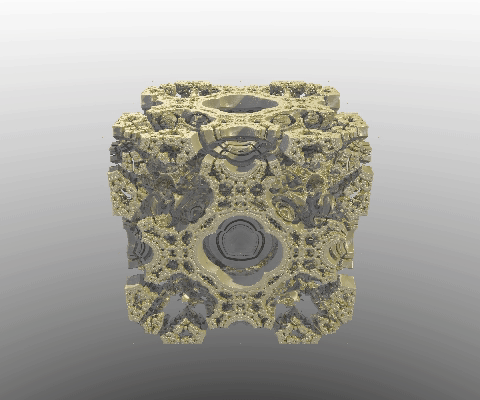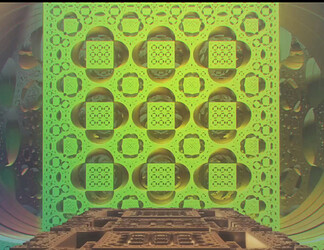忙了半个月其他的事情,早上upgrade一看taichi的版本已经更新到6.10+了 ,不得不佩服各位的肝力_(:3」∠)_
有了taichi_glsl,正好方便补点作业抄点作业了。
看论坛里清一色的fractal和shadertoy,大家都玩的比较欢。想起曾经看过的一部动画《正解的卡多》,里头变换莫测的主题场景就是用分形艺术作成的3D Cube —— MandelBox,曼德勃罗集的高维扩展。
今天我就来玩点 3D fractal,用taichi还原一下动画里魔幻的Cube吧_(:3」∠)_
迭代公式从MandelBrot Set的方程扩展而来,算法很简单,可见wiki介绍 。
实现效果如下:

上传大小限制,只能传个48帧了,有兴趣的朋友可以直接跑一下代码 _(:3」∠)_
代码通过设定全局变量,令Cube的形态跟随参数scale和r值变化。
渲染则参考了shadertoy上的一些raymarching实现。
import taichi as ti
import taichi_glsl as ts
ti.init(arch=ti.gpu)
(w , h) = (640,480)
pixels = ti.Vector(3 ,dt = ti.f32 , shape=(w,h))
iResolution = ts.vec(w,h)
scale = ti.var(ti.f32 , shape=())
camdis = ti.var(ti.f32 , shape=())
min_radius = ti.var(ti.f32 , shape=())
fix_radius = ti.var(ti.f32 , shape=())
dr = ti.var(ti.f32 , shape=())
ds = ti.var(ti.f32 , shape=())
scale[None] = -4 #2.0
camdis[None] = 8
min_radius[None] = -2
fix_radius[None] = 2
dr[None] = 0.001
ds[None] = 0.005
@ti.func
def mandelbox(z):
offset = z
dz = 1.0
for i in range(0,10):
# box fold
z = ts.clamp(z , -1.0 , 1.0) * 2.0 - z
# ball fold
r2 = ts.dot(z ,z )
if r2 < min_radius[None] :
tmp = (fix_radius[None] / min_radius[None])
z *= tmp
dz*= tmp
elif r2 < fix_radius[None] :
tmp = fix_radius[None] / r2
z *= tmp
dz*= tmp
z = scale * z + offset
dz= dz * ti.abs(scale) + 1.0
return ts.length(z) / ti.abs(dz)
@ti.func
def scene(pos):
return mandelbox(pos)
@ti.func
def raymarcher(ro , rd) :
maxd = 60.0
precis = 0.01
h = precis * 2.0
t = 0.0
res = -1.0
for i in range(0,100):
if h < precis or t > maxd :
break
h = scene(ro + rd * t)
t += h * 1.0
if t <= maxd :
res = t
return res
@ti.func
def background(rd):
v = 1.0 + 1.2 * rd[1]
return ts.vec(v,v,v)
@ti.func
def ambocc(pos , nor):
occ = 0.0
sca = 1.0
for i in range(0,5):
hr = 0.01 + 0.12 * float(i)/ 4.0
aopos = nor * hr + pos
dd = scene(aopos)
occ += -(dd-hr) * sca
sca *= 0.95
return ts.clamp(1.0 - 3.0 * occ , 0.0 , 1.0)
@ti.func
def light(lightdir , lightcol , tex , norm ,camdir):
cosa = ti.pow(0.5 + 0.5 * norm.dot(-lightdir) , 2.0)
cosr = ti.max((-camdir).dot(ts.reflect(lightdir , norm)) , -0.0)
diffuse = cosa
phong = ti.pow(cosr , 8.0)
return lightcol * (tex * diffuse + phong)
@ti.func
def normal(pos) :
eps = 0.005
v1 = ts.vec3( 1.0,-1.0,-1.0)
v2 = ts.vec3(-1.0,-1.0, 1.0)
v3 = ts.vec3(-1.0, 1.0,-1.0)
v4 = ts.vec3( 1.0, 1.0, 1.0)
return ts.normalize(
v1 * scene(pos + v1 * eps) +
v2 * scene(pos + v2 * eps) +
v3 * scene(pos + v3 * eps) +
v4 * scene(pos + v4 * eps))
@ti.func
def softray(ro , rd , hn):
res = 1.0
t = 0.0005
h = 1.0
for i in range(0,40):
h = scene(ro + rd * t)
res = ti.min(res , hn * h / t)
t += ts.clamp(h, 0.02 ,2.0)
return ts.clamp(res , 0.0 , 1.0)
@ti.func
def material(pos , camdir):
norm = normal(pos)
d1 = - ts.normalize(ts.vec(5.0 , 10.0 , -20.0))
d2 = - ts.normalize(ts.vec(-5 , 10.0 , 20.0))
d3 = - ts.normalize(ts.vec(20 , 5.0 , -5.0))
d4 = - ts.normalize(ts.vec(-20.0, 5.0 , 5.0))
tex = ts.vec(0.2 , 0.2 , 0.2)
if pos[1] > -5.95 :
tex = ts.vec3(0.32,0.28,0.0)
sha = 0.7 * softray(pos , - d1 , 32.0) + 0.3 * softray(pos , -d4 , 16.0)
ao = ambocc(pos , norm)
l1 = light(d1, ts.vec3(1.0,0.9,0.8), tex, norm, camdir)
l2 = light(d2, ts.vec3(0.8,0.7,0.6), tex, norm, camdir)
l3 = light(d3, ts.vec3(0.3,0.3,0.4), tex, norm, camdir)
l4 = light(d4, ts.vec3(0.5,0.5,0.5), tex, norm, camdir)
return 0.2 * ao + 0.8 * (l1 + l2 + l3 + l4) * sha
#return 0.5 * ao + 0.5 * (l1 + l2 + l3 + l4) * sha
@ti.func
def render_ray(campos , camdir ) :
col = ts.vec(0.0 , 0.0 , 0.0)
dist = raymarcher(campos , camdir)
if dist == -1.0 :
col = background(camdir)
else :
inters = campos + dist * camdir
col = material(inters , camdir)
return col
@ti.func
def cal_look_at_mat(ro , ta , roll) :
ww = (ta - ro ).normalized()
uu = ts.cross(ww , ts.vec3(ts.sin(roll) , ts.cos(roll) , 0.0)).normalized()
vv = ts.cross(uu ,ww).normalized()
return ts.mat(
[uu[0] , vv[0] , ww[0]] ,
[uu[1] , vv[1] , ww[1]] ,
[uu[2] , vv[2] , ww[2]] )
@ti.func
def main_image(t , i , j):
fragcoord = ts.vec(i,j)
xy = (fragcoord - iResolution / 2.0) / max(iResolution[0] , iResolution[1])
campos = ts.vec(camdis[None] * ts.cos(t / 5.0) , camdis * 0.5 , camdis[None] * ts.sin(t/5.0))
camtar = ts.vec(0.0,0.0,0.0)
camdir = (cal_look_at_mat(campos , camtar , 0.0) @ ts.vec3(xy[0] , xy[1] , 0.9)).normalized()
return ti.pow(render_ray(campos , camdir) , ts.vec(1.0/2.2 , 1.0/2.2 , 1.0 /2.2))
@ti.kernel
def paint(t : ti.f32):
global dr , ds
scale[None] += ds[None]
min_radius[None] += dr[None]
fix_radius[None] -= dr[None]
if scale[None] > 0 or scale[None] <-6 :
ds = -ds
if min_radius >= fix_radius or min_radius <= -2 or fix_radius >= 2 :
dr = -dr
for i , j in pixels :
pixels[i,j] = main_image(t * 0.03 , i , j)
def main():
gui = ti.GUI("Mandelbox" ,(w,h))
for ts in range(1000000):
paint(ts)
gui.set_image(pixels)
gui.show()
if __name__ == '__main__':
main()
关于MandelBox:

